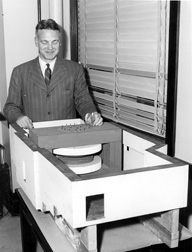Robert Maynard Hutchins (1899-1977) was an American educator and the President of the University of Chicago.
Hutchins was born in Brooklyn. He studied at Oberlin College and Yale University, and while working as Secretary of the Yale Corporation he also earned a law degree from Yale. He became a law professor and was appointed Dean of the Yale Law School three years later. In 1929, he was named President of the University of Chicago, the youngest at any major American university in history.
After the start of World War II in 1939, Hutchins offered the United States government the full resources of the university. Hutchins had canceled the university’s football program in the same year, so Enrico Fermi and his team set up Chicago Pile-1, the world’s first self-sustaining nuclear chain reaction, in an abandoned squash court under Stagg Field. The Manhattan Project was not the only government work conducted at the University of Chicago, as it also saw the creation of military training programs for radio technology, meteorology, and languages.
Only days after the bombings of Hiroshima and Nagasaki, Hutchins participated in a radio discussion, “Atomic Force: Its Meaning for Mankind.” Hutchins suggested the need for a “world constitution” and was soon approached by Leo Szilard about having a scientific conference to discuss the future of the Atomic Age. In 1947, the University of Chicago published a Preliminary Draft of a World Constitution. For the next four years it would also publish a journal, Common Cause, dedicated to the issue of world government.
After leaving Chicago in 1951, Hutchins became the head of the Ford Foundation. He worked for the Foundation-affiliated Fund for the Republic, which supported civil liberty issues, including Hollywood actors and actresses blacklisted because of McCarthyism. Hutchins would also go on to found a think tank, the Center for the Study of Democratic Institutions.
Robert Hutchins died on May 17, 1977 in Santa Barbara, California.





